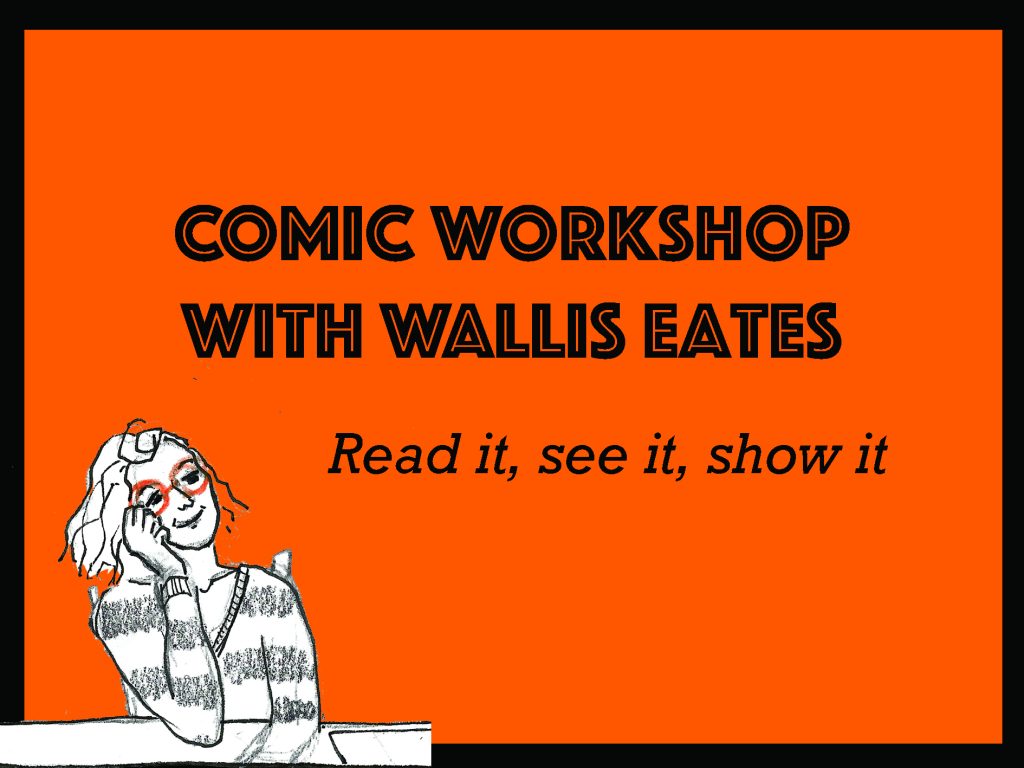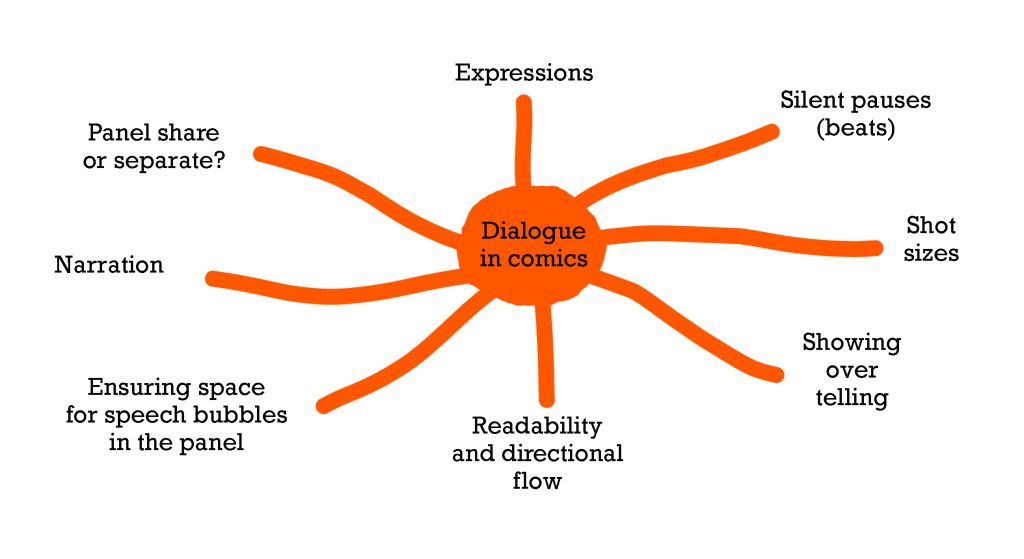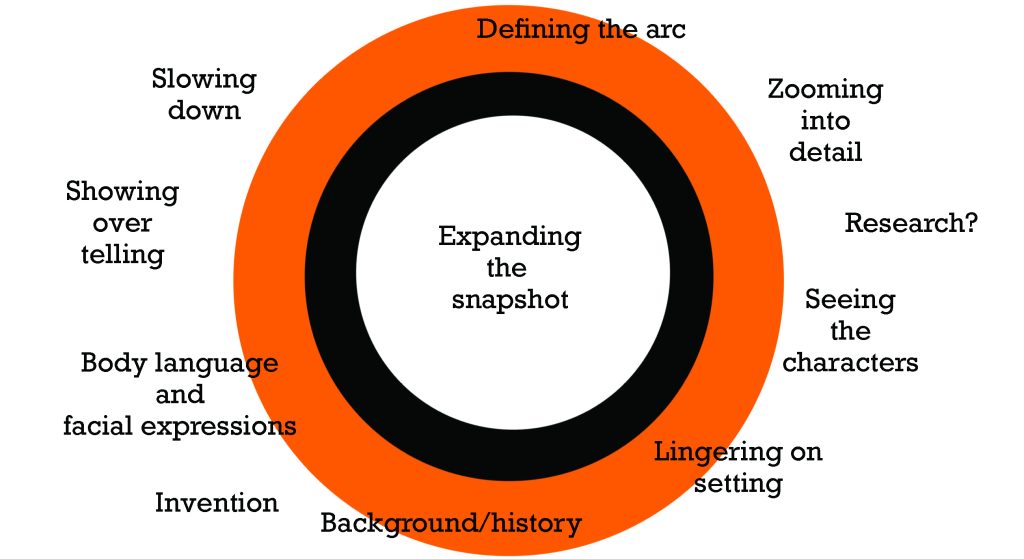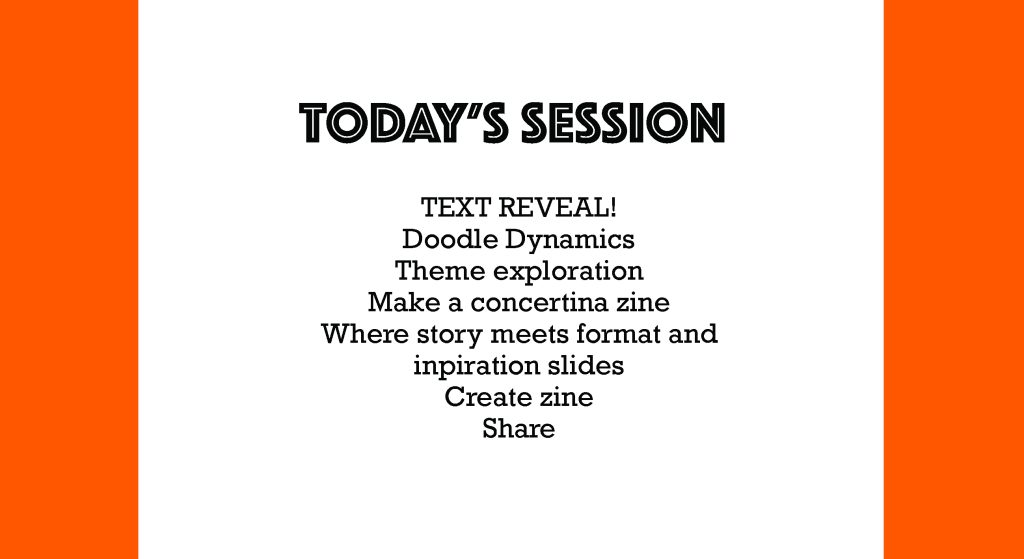By Wallis Eates
Having previously run courses for Pen to Print on how to make comics, I was delighted to be invited back to try something slightly different this year. The online course, ‘Read It, See It, Show It’ continued to incorporate comic elements in our practical activities, such as character design and sequential drawing, as well as making zines, but with added text analysis, delving into writing from a variety of sources and genres, and from a diverse range of voices. They included modern classics, poems, articles from Victorian newspapers, dialogue, graphic memoir, non-fiction, fantasy, plus some children’s stories for good measure.

In each session, we approached the following texts by exploring key themes to build a visual language, and then towards a final piece of bringing it all together. It was also great to signpost other creators out there who are making comics that resonate with the topics we were exploring. No prior reading of the texts were necessary, as extracts were sent via email after I did the big ‘text reveal’. I then read the text out loud and invited everyone to doodle along, capturing the first images and ideas that came to mind.
SESSION 1: Cider With Rosie by Laurie Lee.
This was on the syllabus way back when I did English A Level and I was always struck by Lee’s visually powerful writing. For this opening session, we read the beginning, which describes Lee’s memories of being a small boy and moving into a new house in rural England at the dawn of the industrial revolution. Everything was hustle and bustle around him, while he was perfectly still. His sisters provided familiarity, while where he sat was new. This lent itself to exploring character in setting with our drawings, and connecting the two by considering the child’s point of view, as well as seeing him small in his surroundings. When there is so much going on in the text, as there is with Cider With Rosie, it can be useful to jot down a few words that sum up the feel, and use those to refer to when making your drawings.
SESSION 2: Diary Of A Teenage Girl by Phoebe Gloeckner
Most diaries of teenagers are full of descriptions of themselves! We defined inner and outer worlds through different pieces of text from Gloeckner’s graphic memoir to design the eponymous character. Looking at her likes and dislikes, workshop participants invented scenarios through which to play out the character’s expressions and ways of moving. It was interesting to see the many visual interpretations of the character and then to reveal the original from the book.
SESSION 3: The Very Bad Girl Scouts by John P McEneny
The focus on this session was dialogue. I was very happy that Habib, the facilitator from Pen to Print, was game in reading out an extract from the play with me. After we’d impressed everyone with our top-notch acting skills, we went back to the world of comics by considering different ways dialogue can be read within the medium. Speech bubbles are a well-known tool in comics, but when do characters share a panel and when do they have their own? When is it a good idea to have a panel with no dialogue, allowing facial expression and body language to fill a ‘beat’ instead? What kind of pacing are we after? It’s always a good idea, when working with text in a comic, to plan where your text is going to go before you start drawing. And, remember, in the West, we read from left to right!
 SESSION 4: Human Family by Maya Angelou
SESSION 4: Human Family by Maya Angelou
We began this session by watching a video clip of Maya Angelou recite her poem, The Human Family. With central themes of differences and universalities across all people, the poem offered a wonderful opportunity to explore visual motifs and abstraction to illustrate the stanzas. One rule of thumb when it comes to visualising text, is to think carefully before drawing exactly what has already been written – can it be complemented instead?
SESSION 5: Moving Molly by Shirley Hughes
Hughes’ sumptuous illustrations for her children’s book, Moving Molly set the bar high this week! We took inspiration by looking at the ways in which Hughes brought to life the character of Molly in her various settings. We saw point-of-view shots, the back of Molly in her surroundings, Molly pondering what is around her, and the odd example of size-exaggeration. We also looked at compositional devices, such as drawings that circulate the text on a page to provide a frame, and panels that sit either side of text suggesting the passing of time, while observing how these devices guide the eye across the page. Finally, we noted how Hughes had made the inner world of Molly’s imagination visible to the reader. Participants were challenged to try out each of these approaches for themselves with selected extracts of text from the story.
SESSION 6: News From The English Countryside 1750 – 1850
Weird and wonderful stories of times past provided the prompts for this session’s activities, as we utilised the concise written style of the news bulletin to explore the element of time in the comics format. The first task was to draw a moment from the story that would work as a summary of its headline. We then got into the nitty-gritty of sequencing with panels to explore the moment, its build-up and aftermath. A great resource for understanding the many ways in which time can pass through a sequence of panels in comics is Scott McCloud’s analysis and samples in his brilliant, comprehensive book, Understanding Comics.

SESSION 7: The Book Of Imaginary Beings by Jorge Luis Borges
An array of mythical, obscure, famous and infamous characters jumped out of Borges’ exquisite collection of beings and onto the pages of the participants in this session. Rooted in mythology, religion and culture, the form of such creatures are more often than not integral to the stories of their existence. Many eyes, limbs, or strange ink-drinking habits, for example, all provide context and inspiration for the illustrator, who can imbue them with personality and tell their story in how they are drawn.
SESSION 8: Underland by Robert MacFarlane
We returned back down to earth and below for session eight, as we took a dive deep into the past and read about the markings left by prehistoric people in underground landscapes. MacFarlane’s brilliant research provides a multi-layered approach to his subject, revealing not only the discoveries of incredible underground expeditions, but the researchers and their stories too. This gave the participants lots to go on by way of their own explorations through the text, taking initial inspiration from dancing red figures on ancient cave walls through to detailed descriptions of awe by the contemporary onlooker. With the tools of pen, paper and imagination they could divide the page into panels to draw vast expanses of space, time and human creativity.
SESSION 9: On The Turn by Rumi
After the text-dense material of the last session, we now turned our eye and hand to this four-lined poem by 13th century Persian mystic poet, Rumi. However small in length it may be, its expansive themes of love, awe and mystery provided the inspiration for everyone to make a zine to explore their own interpretations visually. A zine is essentially a DIY magazine or booklet, and can be a great way to put together a body of work without going to a publisher!
SESSION 10: The Tunnel by Anthony Browne
A creative writing tutor of mine once pointed out to me that all endings must somehow go back to the beginning – a reflection of sorts, to see what has changed since it all began. This is what makes a story a story, and it’s also how we make sense of life! It’s a notion famously consolidated in Joseph Campbell’s work, The Hero’s Journey, which is a must-read for any budding writers. I chose to end the course with The Tunnel by Anthony Browne, as it’s a prime example of a story that ends where it starts – after the characters have been on quite an adventure and each undergoing their own arcs. With the visual and symbolic motif of the tunnel, this story was crying out to be told in a concertina style zine. So for the final session, this is what we did, playing around with perspectives, beginnings and endings. I like to think that, just because a course comes to an end, it doesn’t mean the journey has to stop.
 *****
*****
Without fail, every session threw up incredible work by the participants. Everybody had their own learning and practice experiences as they immersed themselves in the text, bringing out what inspired them into their own fresh take. I loved Emily’s inventive use of multiple timelines in her response to Underland, and how both Eszter and Rachel made their concertina zines for The Tunnel utterly unique and beautiful. It was also wonderful how we always had a contribution from Rosemary, who would share her brilliant digital creations in the ‘chat’ section. Well done everyone!
I will be running a modified version of this course again in September. As before, the sessions are online and can be attended drop-in style or across the whole course. No prior reading of the texts are necessary and all levels of experience are welcome. For more details or to book, follow this link here: tickettailor.com/events/walliseates/731123
Connect with Wallis on Twitter: @walliseates and Instagram: @walliseates.
*****
Feedback by Comic Book Workshop attendee Eszter:
The Pen to Print Comic Book Workshops with Wallis became unexpectedly important and meaningful for me. Maybe that’s why I’ve been struggling to eloquently summarise my experience. I cannot recall how I came across it, but I can recall how apprehensive I was about giving it a go. But then I did and I was most surprised by how productive and immersed I’ve been during the first session and every session afterwards. My own creative force surprised me every time. A priceless experience.
I’ve been looking forward to the next session with excitement and anticipation week by week. And I’m not exaggerating when I say I look forward to January, when hopefully there will be another series of these workshops. I can’t wait to see what I’ll create. And what everybody else will create. Being able to see other people’s work has been super fun and the creative spirit has been very high all along. It’s been great to meet people and have a little insight to their work. It’s been also wonderful to see how diverse the group was in terms of skills and background.
What I found amazing is how Wallis managed to facilitate such a productive and meaningful event via Zoom. I still can’t put my finger on it. Maybe something to do with the content and the tasks, the pace of the session, or Wallis’ calm and kind demeanour. She’s encouraging and supportive and certainly very well prepared. I really enjoyed the introductions to the works of different artists I was not familiar with.
Also, a big thank you to Habib. Such a privilege to have the help and support of the great team behind Pen to Print!
I can’t believe I could access the workshops for free. Money would have been a barrier for me. I know there’s a lot of work going into getting funding in place for making these opportunities accessible and I’m very grateful to everyone for making this possible.
*****
Read the latest issue of Write On! (13) magazine online here.
You can hear great new ideas, creative work and writing tips on Write On! Audio. Find us on all major podcast platforms, including Apple and Google Podcasts and Spotify. Type Pen to Print into your browser and look for our logo or find us on Anchor FM.
*****
If you or someone you know has been affected by issues covered in our pages, please see the relevant link below for information, advice and support: https://pentoprint.org/about/advice-support/


